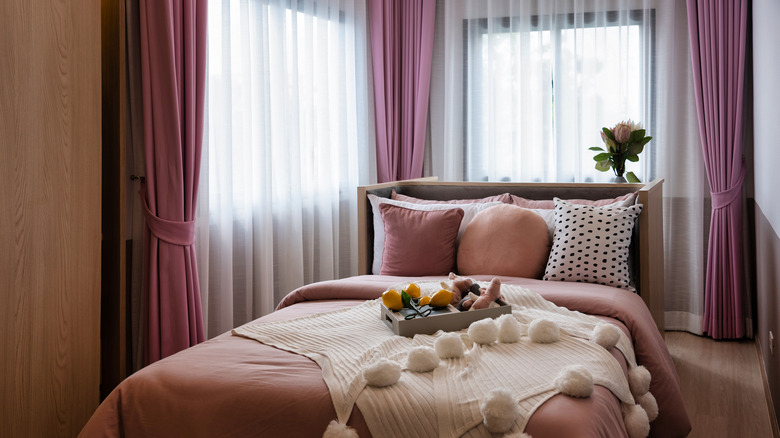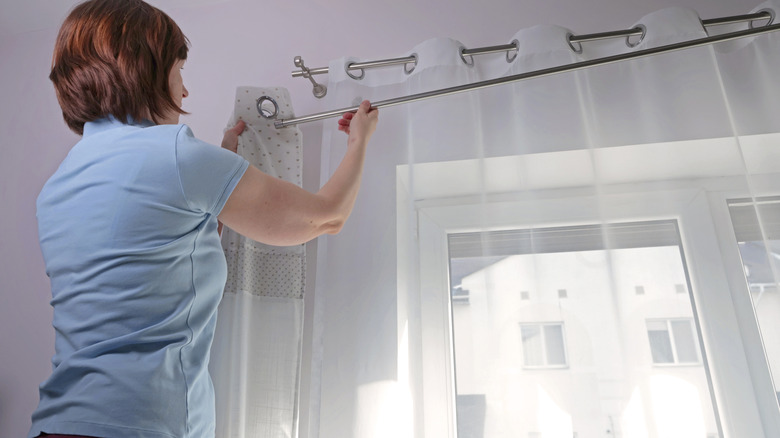The Budget-Friendly Curtain Alternative That Only Looks Expensive
We may receive a commission on purchases made from links.
Sometimes your design style preference is modern chic, but your budget style preference is more "luxe for less". And that's ok, because you can always bend the rules when it comes to choosing the perfect curtains for your space. A mistake that everyone makes when buying curtains is assuming that they need to be expensive to look expensive, which is untrue. Now, does this mean that you're throwing up the dingy old bedsheet from the basement with a few clothespins — no. But there are a lot of creative ways to get chic or elegant curtain vibes without paying close to $75 or more for the high-end ones. Enter random home fabrics. According to @curtainsandconfetti on TikTok, if you search around your home, you're likely to find many textiles that you can use to make your own curtains. Everything from tablecloths to shower curtains and duvet covers can make for great window dressings around your home.
It really just comes down to having fabrics that make for good curtain materials. For example, textiles such as cotton, polyester, rayon, and acrylic make great curtains because they're breathable and affordable. So whether you're interested in saving money or simply moving toward a more eco-friendly and sustainable lifestyle, turning the fabrics around your home into suitable window coverings may be worth exploring. And you don't need a sewing machine to make this happen. However, what you will need is a measuring tape, like the Komelon tape measure, a pair of scissors, and hemming tape, like the Klangfeiler hemming tape to ensure that your curtains fit as well as if you had bought them from Williams Sonoma.
Steps to make DIY curtains from overlooked home fabrics
The best type of curtains for your living room, kitchen, bedroom, or any other room in your home is one that fit the window adequately. To ensure this, be sure to measure your windows and the height of the wall to know what size curtains work best as a treatment, especially if you plan to hang them high on the wall. Next, measure your chosen fabric and ensure that it's clean, wrinkle-free, and of adequate size. Then, lay the curtain backside up on a clean work table. If the fabric is longer than needed, you can fold any excess fabric evenly and neatly at the top of the curtain.
Or, you can hem the fabric and save the leftover cuts for other potential projects. To do this, cut the fabric from the bottom to the appropriate length, plus an additional 2 inches. So for example, if your desired fabric length is 70 inches, cut the fabric to 72 inches. Afterward, fold the fabric inward at the 2-inch mark, and apply the hemming tape inside the fold. Then, iron over it to melt the tape into place (ensure the type of fabric you're using can withstand the heat). The next step is to attach the curtain rod's clip rings to the top of your fabric, making sure that they're evenly spaced apart (about 4 to 8 inches is ideal). Want pleats? Simply pinch the fabric together with your thumb and index finger at the folded edge. And while holding the clip open, place the folded edge inside to hold it in place.
Ways to customize your DIY curtains
Creating a set of homemade curtains doesn't mean that you can't customize them to show off your amazing decorating style. For example, you can use fancy clip rings or grommets to give the curtains a more sophisticated or refined look. And on top of that, you can take a hemmed piece of leftover fabric or a thick rope and use it to tie the curtains back, opening the room up with a bit of sunlight. You can also simply layer the curtains with a complementary color for more pop and dimension in a room that may seem bland.
For example, consider layering your dark gray curtains with an eggshell or pearl white curtain to add some contrast. If you want a more eclectic vibe, consider adding buttons to your curtains as well. This unique look is sure to be remembered and can easily be accomplished with a bit of glue, like Aleene's fabric glue. You can also tap a bit further into your creativity by using stencils to add designs such as plants, shapes, and word art.

